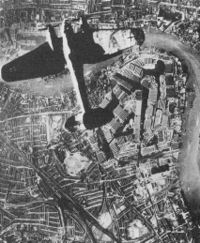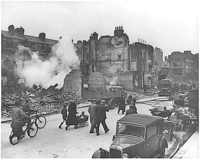The Blitz
2007 Schools Wikipedia Selection. Related subjects: British History Post 1900
The Blitz was the sustained bombing of the United Kingdom by Nazi Germany between 7 September 1940 and 16 May 1941. It was carried out by the Luftwaffe, and hit many towns and cities across the UK, but the main attack was concentrated on London. The Blitz inflicted about 43,000 deaths and destroyed more than a million houses, but failed to achieve the Germans' strategic objectives of knocking Britain out of the war or rendering it unable to resist an invasion.
Although the word Blitz is a shortening of the German word blitzkrieg, meaning "lightning war," it was not an example of blitzkrieg but was an early example of strategic bombing. The literal translation of the German word "Blitz" is "lightning."
In 1944 during the "Little Blitz", aerial attacks resumed with the Germans using V1s and V2s .
Prelude
After the fall of France, the Battle of Britain began in July 1940. From July to September, the Luftwaffe frontally attacked Royal Air Force Fighter Command to gain air superiority as a prelude to invasion. This involved the bombing of fighter airfields to destroy Fighter Command's ability to combat an invasion.
The RAF came much closer to defeat than was publicly admitted at the time and had the Luftwaffe persisted, it might have achieved air superiority. However, the Germans overestimated the RAF's strength and believed that they first needed to destroy strategic installations such as aircraft factories and dockyards and thus deny the RAF the replacements it required. In late August 1940, before the date normally associated with the start of the Blitz, the Luftwaffe attacked industrial targets in Birmingham and Liverpool.
During a raid on Thames Haven, on 24 August 1940, some German aircraft strayed over London and dropped bombs in the east and north-east of the city, Bethnal Green, Hackney, Islington, Tottenham and Finchley. This prompted the British to mount a retaliatory raid on Berlin the next night with bombs falling in Kreuzberg and Wedding. Hitler was said to be furious and on 5 September issued a directive stating a requirement "...for disruptive attacks on the population and air defences of major British cities, including London, by day and night". The Luftwaffe began day and night attacks of British cities, concentrating on London. This relieved pressure on the RAF's airfields.
First phase
The first air raids on London were mainly aimed at the Port of London in the East End. The damage was severe, with the raid of 7 September involving 300 bombers escorted by 600 fighters. Another 180 bombers attacked that night. Many of the bombs aimed at the docks fell on neighboring residential areas, killing 436 Londoners and injuring another 1,600.
British defences were poor. Few of the defenders' anti-aircraft guns had fire-control systems and the underpowered searchlights were usually ineffective at altitudes above 12,000 ft (3,600 m). Even the fortified Cabinet War Rooms, the secret underground bunker hidden under the Treasury to house the government during the war, would have been susceptible to a direct hit from enemy bombing (it was never hit). Few fighter aircraft were able to operate at night and ground-based radar was limited. During the first raid, only 92 guns were available to defend London. The city's defenses were rapidly reorganised by General Frederick Pile, the Commander-in-Chief of Anti-Aircraft Command and by 11 September twice as many guns were available and under orders to fire at will. The consequent barrage was much more impressive, boosted civilian morale and though it had little effect on the raiders there was something of a deterrent effect, encouraging crews to drop early, since the anti-aircraft fire was visible to the bomber crews.
During this first phase of the Blitz, an average of 200 bombers attacked London every night but one between mid-September and mid-November. Most were German but included some Italian aircraft operating from Belgium. Birmingham and Bristol were attacked on 15 October, while the heaviest attack of the war so far — involving 400 bombers and lasting six hours — hit London. The RAF opposed them with 41 fighters but only shot down one Heinkel bomber. By mid-November, the Germans had dropped more than 13,000 tons of high explosive and more than 1 million incendiary bombs for a combat loss of less than 1% (although planes were of course being lost in accidents caused by night flying and night landing).
Second phase
From November 1940 to February 1941, the Luftwaffe attacked industrial and port cities. Targets included Coventry, Southampton, Birmingham, Liverpool, Bristol, Swindon, Plymouth, Cardiff, Manchester, Sheffield, Portsmouth, and Avonmouth. During this period, fourteen attacks were mounted on ports, nine on industrial targets inland and eight on London.
Probably the most devastating of these raids, in terms of material destruction, occurred on the evening of the 29 December in what has been dubbed The Second Great Fire of London in which an embattled St Paul's Cathedral provided an iconic image of London's resistance.
British defences were still fairly weak and German losses were sustainable — only 75 aircraft during these four months. The German High Command became sceptical about the campaign, since the bombing was not affecting the RAF and with the RAF intact, an invasion of Britain was unfeasible. Preparations were underway for Operation Barbarossa, the invasion of the Soviet Union, which (in Hitler's eyes) had more priority than reducing Britain.
Third phase
In February 1941, Grand Admiral Erich Raeder persuaded Hitler to attack British ports in support of the Kriegsmarine's Battle of the Atlantic. Hitler issued a directive on 6 February ordering the Luftwaffe to concentrate its efforts on ports, notably Plymouth, Portsmouth, Bristol and Avonmouth, Swansea, Liverpool, Belfast ( main article: Belfast blitz), Clydebank, Hull, Sunderland, and Newcastle. 46 attacks were mounted against those cities between 19 February and 12 May, with only seven directed against London, Birmingham, Coventry, and Nottingham.
By this time, the effort was aimed as much against civilians as against industrial targets and the raids were intended to provoke terror. British defenses were much improved by this time. The Bristol Beaufighter, with airborne radar, proved effective against bombers with ground-based radar guiding night fighters to their targets. An increasing number of anti-aircraft guns and searchlights were radar-controlled, improving accuracy. From the start of 1941 the Luftwaffe's losses mounted (28 in January, 124 in May). With the impending invasion of the Soviet Union requiring the movement of air power to the East, the Blitz ended in May 1941.
One last major attack on London happened on 10 May, where many important buildings were destroyed or damaged, among them the British Museum, Houses of Parliament and St. James's Palace.
Baedeker Blitz
The Baedeker Blitz was a series of raids conducted in mid- 1942 as reprisals for the RAF bombing of the German city of Lübeck. The Baedeker raids targeted historic cities with no military or strategic importance such as Bath, Canterbury, Exeter, Norwich and York. Churches and other public buildings were often the targets of these raids in an attempt to break civilian morale.
With regard to civil defences, the number of public bomb shelters fell far below the required number, forcing the authorities in London to make use of about eighty London Underground stations to house about 177,000 people. In contrast, the Germans made a much more concerted and organised effort to shelter their population against the Allied strategic bombing campaign later in the war.
Great improvements were made to air defenses during the Blitz. This proved something of a propaganda coup, and much was made of the stoicism of the British people, encapsulated in the 1940 propaganda film London Can Take It, made by Humphrey Jennings.
American radio journalist Edward R. Murrow was stationed in London at the time of the Blitz and he made live radio broadcasts to the United States during the bombings. Live broadcasts from a theatre of war had not been heard by radio audiences before and Murrow's London broadcasts made him a celebrity. His broadcasts were enormously important in prompting the sympathy of the American people for Britain's resistance to Nazi aggression.
Little Blitz
- June 12, 1944: First V-1 Flying Bomb attack on London inaugurates the Little Blitz. The British defence against the V-1 was codenamed Operation Diver.
- September 8, 1944: First V-2 Rocket attack on London.
- September 17, 1944: The Blackout is replaced by a partial 'dim-out'.
Major sites, structures, and churches damaged or destroyed in the Blitz
- All Hallows by-the-Tower
- All Hallows-on-the-Wall
- Bank tube Station - January 11, 1941
- Bounds Green Station - October 13, 1940
- British Museum - May 10, 1941
- Buckingham Palace
- Café de Paris - March 8, 1941
- Central Telegraph Office - December 29, 1940
- Chelsea Old Church
- Christ Church, Newgate
- City Temple
- Dutch Church
- Euston station - November 15, 1940
- Guildhall - December 29, 1940
- Holland House
- Houses of Parliament (Palace of Westminster) - May 10, 1941
- Lambeth Palace - May 10, 1941
- Lambeth Walk - September 18, 1940
- London Library
- Marble Arch Underground Station - September 17, 1940
- National Portrait Gallery - November 15, 1940
- Old Bailey - May 10, 1941
- Paternoster Row - December 29, 1940
- Portsmouth Guildhall
- Portsmouth Harbour railway station
- Shell Mex House - September 15, 1940
- St. Joseph's RC Primary school- May 10, 1941
- St Alban Wood Street
- St Alfege's Church, Greenwich - March 19, 1941
- St. Andrew-by-the-Wardrobe
- St Andrew Holborn
- St Augustine Watling Street
- St Bartholomew the Less
- St Botolph Aldersgate
- St Clement Danes
- St Dunstan-in-the-East
- St George in the East - May 1941
- St James Garlickhithe
- St. James's Palace - May 10, 1941
- St Lawrence Jewry - December 29, 1940
- St Luke's Church, Liverpool
- St Mary Abchurch
- St Mary Aldermanbury
- St Mary-le-Bow - May 10, 1941
- St Nicholas Cole Abbey
- St Olave Hart Street
- St Paul's Cathedral - December 29, 1940
- St Vedast alias Foster
- Temple Church
- Westminster Abbey - November 15, 1940
- Westminster Hall - May 10, 1941


